Report

Executive summary
As we described in Volume 1 of this report, China’s decelerating growth and the government’s emphasis on the service sector has introduced important changes for makers of fast-moving consumer goods (FMCG). Sales of products that are traditionally favored by blue-collar workers—such as instant noodles and value beer—are growing at a snail’s pace, or even declining, while products typically purchased by members of the rising middle class—such as yogurt and pet food—are breaking records. The first half of 2016 has shown no change in these trends; the same depressed categories continue to be depressed, while the same robust categories, buoyed by personal care, are enjoying fast growth.
This “two-speed” scenario is playing out in retailing too.
Online sales are maintaining their decade-long boom, while offline sales in most formats continue to barely grow or even lose ground, with the notable exception of convenience stores. Convenience stores now represent a relatively small share of China’s overall retailing market, but will become increasingly important in the years ahead.
Of course, the strongest momentum in China retailing—and the biggest story—is in the online world, which is steadily chipping away at offline sales. Consider the fact that FMCG spending online rose 36.5% in 2015, primarily the result of 69% gain in volume growth, which more than compensated for declines in average selling prices. Increasing diversification in the categories purchased online is contributing to the massive online sales growth, as are the huge gains in imported products and the number of consumers taking advantage of promotions.
As it captures more of China’s FMCG sales, the online world is also undergoing significant changes. For example, consolidation continues at a smooth pace. The top 10 e-retailers accounted for 64% of total FMCG spending online in 2015, compared with 55% in 2014. Among the top four, which represent 55% of all online spending, Taobao, Tmall and JD still dominate, although Taobao’s share has decreased and JD’s recent acquisition of Yihaodian enabled it to take on Tmall as the leader in online grocery.
The undisputed highlight of the online sales year is the annual 11/11 Singles’ Day promotions. In 2016, Alibaba’s site alone registered sales of $17.8 billion during the one-day shopping spree. Our research into Singles Day 2015 activity provided useful new insights into the sales performance of this innovative and uniquely Chinese sales promotion. There are three main engines of growth, all important, contributing to the total spending increase during 11/11 promotions:
- Existing shoppers of an online category purchasing more during 11/11 promotions (e.g., laundry detergent, facial tissue and infant formula).
- Shoppers who previously withheld online purchases to take advantage of the promotions.
- New shoppers attracted to an online category because of the promotions. For categories such as biscuits, fabric softener and shampoo, the majority of the spending increase is due to new shoppers buying from these categories online for the first time, and online promotions serving as an important recruitment tool.
Critically, our data also shows that the online gains during 11/11 are acquired to a large extent at the expense of offline channels.
To win in the years ahead, online retailers will need to adapt their approaches based on these findings and other clear signs of shopper preference. For example, in addition to a propensity for buying on promotion, there is a steady rise in spending for premium brands and imported goods, including, somewhat surprisingly, during the 11/11 promotions.
Meanwhile, physical store retailers are awakening to a new reality. As more shoppers turn to digital options, offline channels are starting to take on an additional role as a complement to online sales. Shoppers once relied heavily on hypermarkets for the bulk of their goods and visited convenience stores to “top off” their purchases when necessary. Now, in increasing numbers, they buy more of what they need online, relying on their laptops or mobile phones instead of traveling to the hypermarket. Again, convenience stores have become a place to top off purchases.
But the growing urbanization trend is adding an extra boost to the popularity of convenience stores, which watched sales grow by 13% last year, according to our annual study of FMCG consumers. Indeed, they are the place for on-the-go purchases and are even emerging as one-stop shops for new occasions—everything from ticket purchases to bill paying. However, this growth is largely the result of new store openings. The big challenge for convenience store players as they enjoy enviable growth is determining how to achieve and maintain profits amid high urban real estate costs.
It is no secret that traditional and larger formats are suffering by comparison. Look at the depressing findings from our survey: traditional trade saw sales decline by 10.4% and hypermarkets by 0.2%. Super/minimarket growth slowed to 4%. These formats face a number of critical choices in the new retailing landscape—everything from reducing network capacity to address declining traffic, to ruthlessly focusing on operational excellence to sustain margins. And retailers in both the physical and digital worlds have a common goal: continue to implement successful online-to-offline (O2O) strategies.
Two-speed China continues
China’s fast-moving consumer goods (FMCG) retail market now moves at two distinct speeds: fast and slow. Online retailers are striving to make the most of their booming channel and the seemingly limitless opportunities. Digital sales grew by 36.5% in 2015. However, in the physical world, the story is completely different. Traditional and larger-store formats continue in their efforts to reverse relatively poor performance. Offline FMCG sales grew by only 2.6% in 2015 and 1.5% in the first half of 2016, with negative volume growth. The only bright light is that convenience stores are performing well, but still face the challenge of managing their impressive growth amid sometimes difficult economics.
Since the end of 2014, FMCG has experienced diverging trajectories between food and beverage, and home and personal care (see Figure 1). For the first half of the year, the total urban FMCG retail market grew by 3% over the same period in 2015, the result of a volume decline of 0.2% and average sales price growth of 3.3% (see Figure 2).
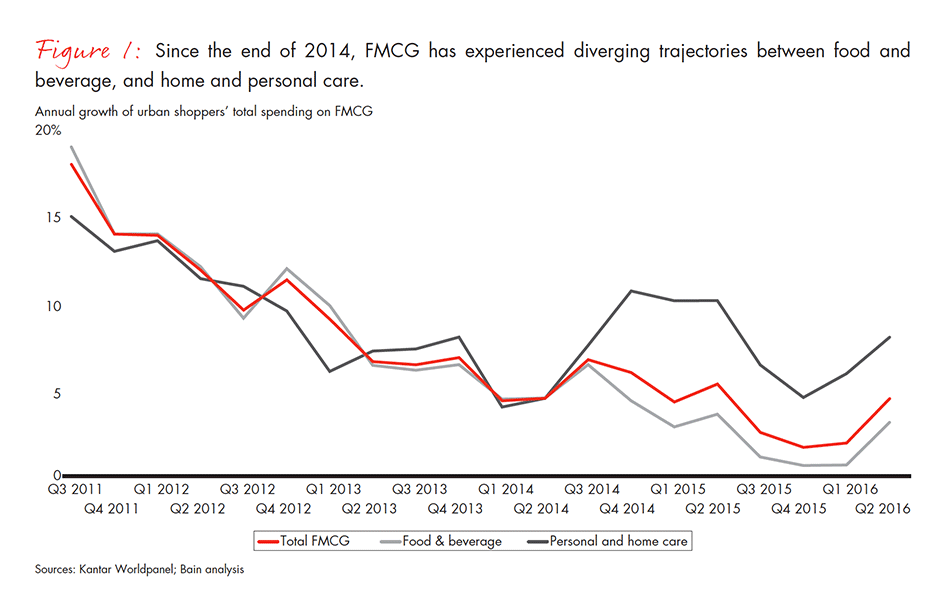
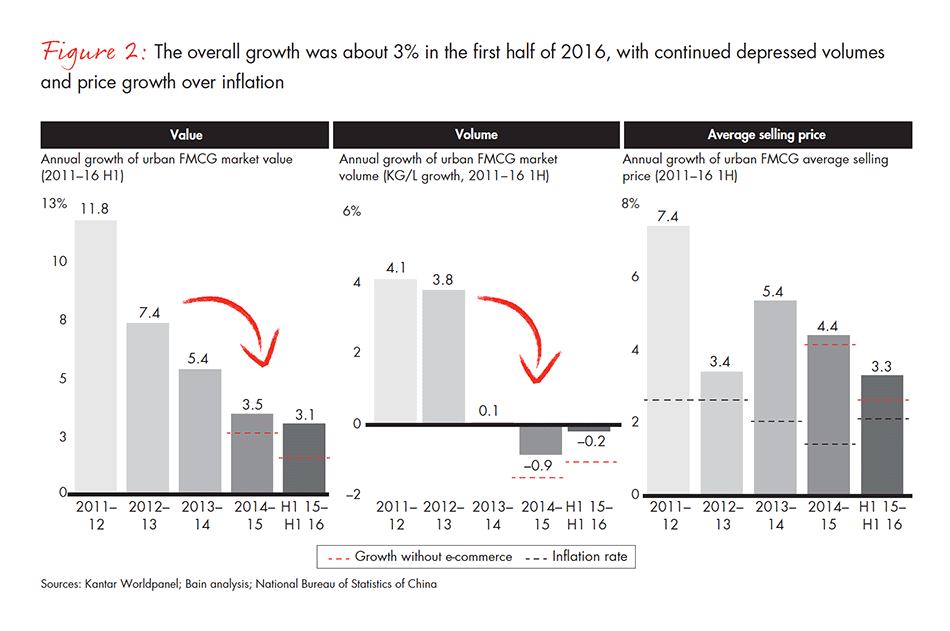
Our 12th consecutive study of the shopping behavior of 40,000 Chinese households helped us gain insights into these and other important consumer and retail trends in China. As in previous years, we equipped research participants with barcode scanners to track what they purchased rather than relying on what they said they’d purchased. This unique approach gave us a clear picture of the purchase activity of shoppers across 26 categories of FMCG.
To understand the two-speed scenario, compare the performance of different product categories. Sellers of personal care products like shampoo and toothpaste have reason to celebrate: They saw a rebound in the first half of 2016. Despite China’s sluggish economy, the personal care category experienced overall growth of 9%, almost entirely the result of average selling prices that rose faster than inflation—what we call “premiumization.” Home care categories like kitchen cleaner, however, continue to be the fastest growing in terms of volume, which rose by 2.9% in the first half of 2016 compared with a 2.3% rate in 2015 (see Figure 3). But the average selling prices rose 0.8%, which is less than the rate of inflation—what we call “commoditization.”
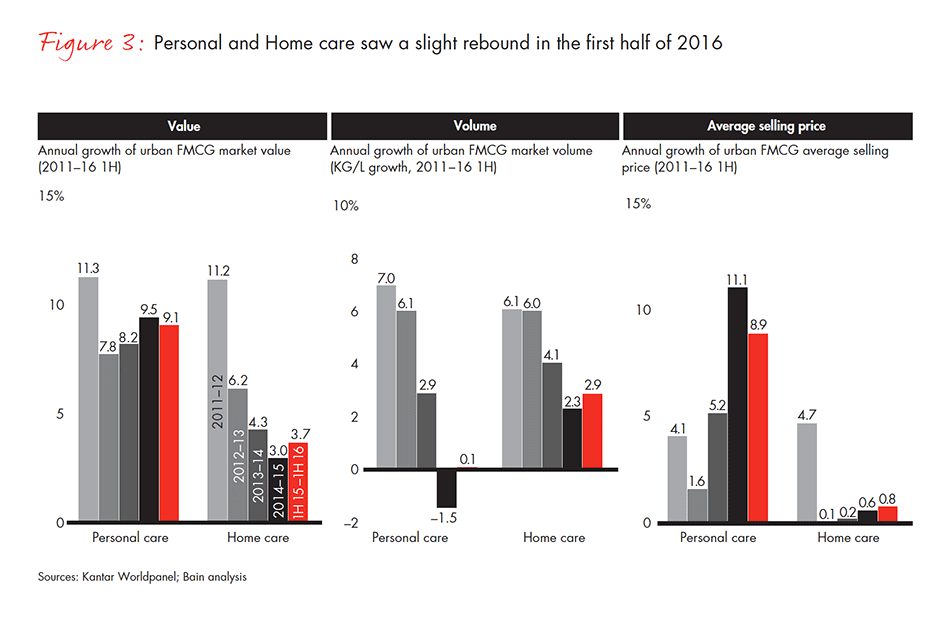
At the same time, many packaged food and beverage categories witnessed a decline (see Figure 4). For example, beverage value growth fell from 5.6% in 2015 to 3.2% in the first half of 2016, with a third straight year of shrinking volume. Average selling prices for beverages rose by only 3.3% in the first half of 2016, compared with 6.2% for the year 2015. These are trends that, in part, have roots in the Chinese government’s “new normal” policy of promoting service industries over manufacturing. Product categories that are traditionally popular with blue-collar workers are losing sales volume, as manufacturing jobs shift to lower-wage countries like Vietnam and Bangladesh. These workers have clearly become more cautious in their spending. But while most beverage categories saw negative growth in the first six months of 2016, there was one notable exception: packaged water. This performance can be attributed to its affordability and to health concerns, which are becoming increasingly important to all consumers and not just the more affluent middle class. Indeed, China’s middle class, which is gaining in numbers along with the rising service economy, is spending more on consumer products related to health and well-being, as well as premium products across a range of categories. This is the major reason for the relatively strong performance in personal care and such food categories as yogurt. However, gum and candy suffered double-digit negative growth in the first half of 2016.
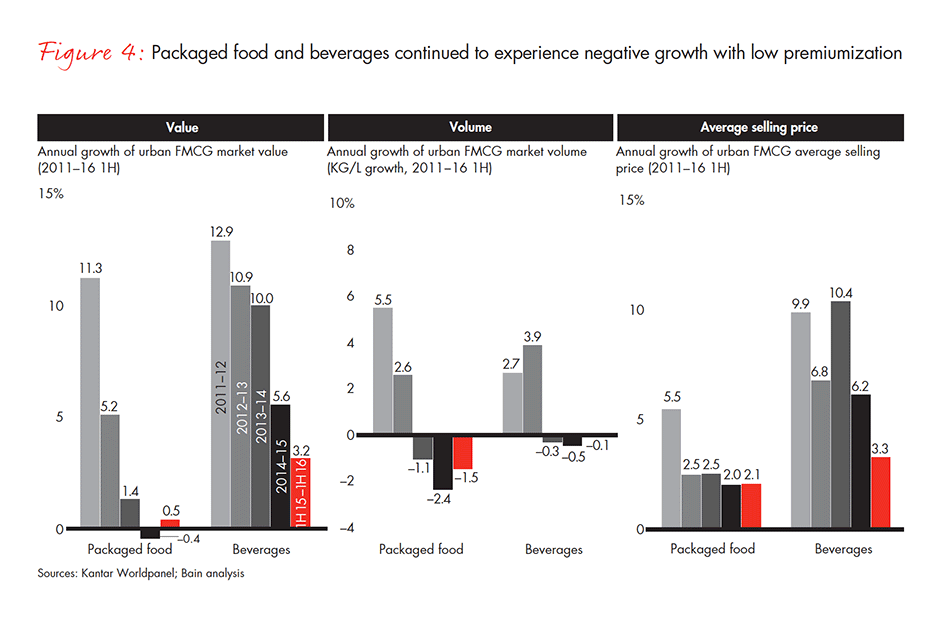
Different retail formats, different trajectories
The two-speed environment that we’ve identified in FMCG sales is highly evident in retailing too. On the one hand, online and convenience stores are enjoying strong momentum. On the other hand, in a continuing trend, supermarket growth slowed and hypermarket sales even declined (see Figure 5).
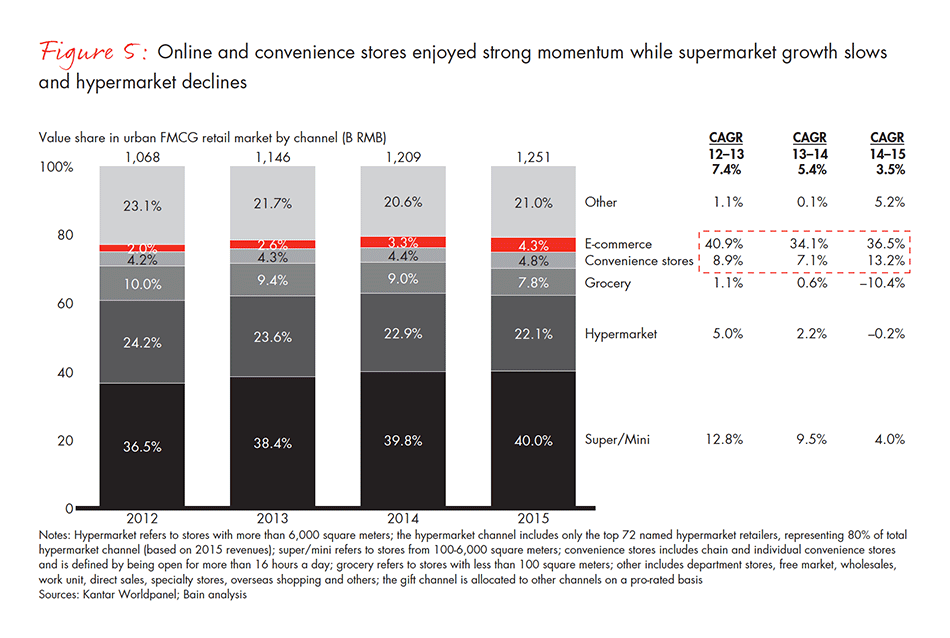
Undoubtedly, traditional groceries, hypermarkets and super/minimarkets remain the slow-speed victims in China retailing. Sales for traditional grocery stores and hypermarkets fell 10.4% and 0.2%, respectively, while super/minimarket growth decelerated to 4%. It was smaller retailers like convenience stores and emerging retail formats like Carrefour Easy, along with specialty stores like Watsons, that contributed most of the FMCG sales growth in 2015 (see Figure 6). Among the leading large-format banners, RT-Mart and Yonghui grew the most, at 12% and 14%, respectively, in 2015 (see Figure 7). Yet that growth appears to be the result of investments made in store expansion despite the weakening channel performance. Across all large-format banners, same-store sales growth continues to decline, with traffic decreasing and sluggish growth in basket size.
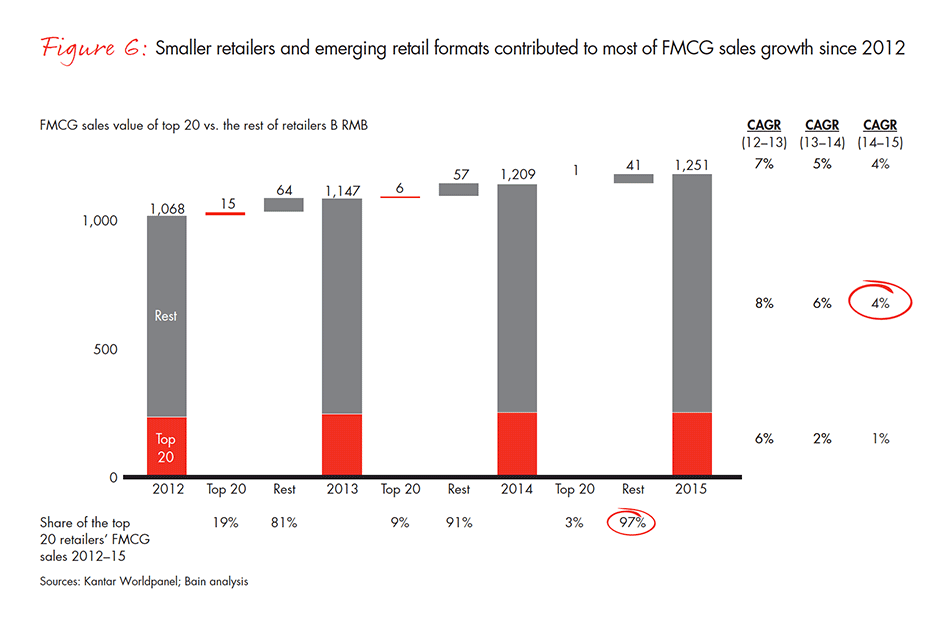
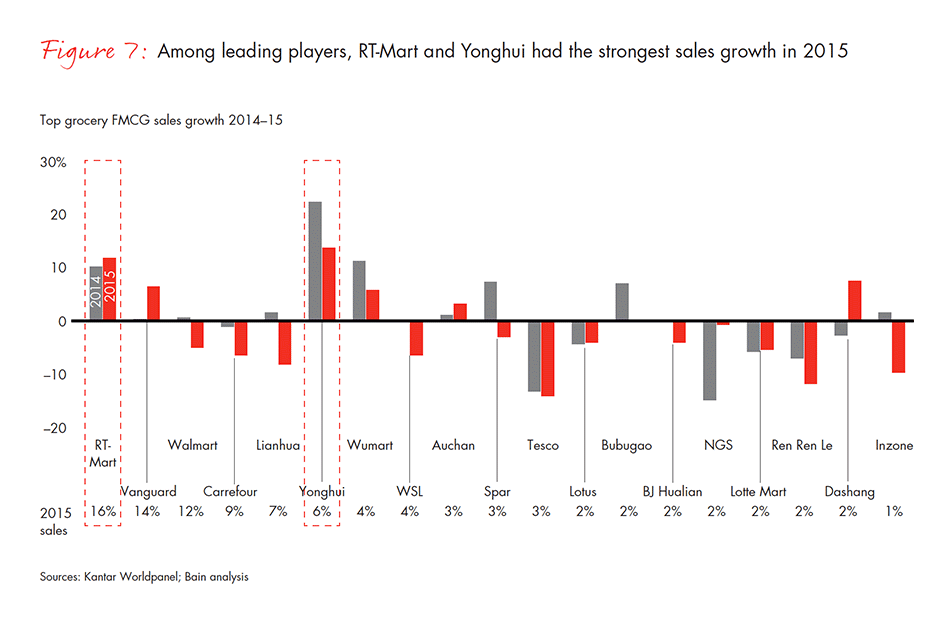
The chronic malaise of traditional hypermarket and super/minimarket formats contrasts with the robustness of convenience stores, which registered more than 13% growth in 2015—nearly twice the 2014 rate. The scale of China’s convenience channel is still relatively small, and much of the growth represents new store openings. Yet this remains an exciting channel to watch. As China becomes more urbanized, shoppers are looking for quick and convenient ways to replace their existing stores and for a place to complement planned online purchases, which represent an ever-increasing share of their regular purchases. Convenience stores not only serve those purposes, but are also emerging as one-stop shops for bill paying, ticket purchases and other innovative services, such as picking up products ordered online. JD, Tmall and other e-commerce platforms are now partnering with convenience store banners to create a win-win model for online-to-offline (O2O) activation with designated convenience stores serving as pickup locations. Picking up products from a centralized convenience store location makes sense. It takes advantage of the broad urban store network and eases the “last-mile” delivery burden for e-retailers like Tmall while driving additional traffic into stores.
The big challenge for convenience stores, however, is one of fundamental economics: They need to devise strategies for expanding reach and maintaining profits amid high urban real estate costs. Again, this is a format that represents the lion’s share of growth in offline sales, and it will only get more interesting as companies invest in the next phase of growth. For example, AM/PM, which quickly expanded in Beijing, plans to multiply that expansion across China in the next five years.
Among the top 10 convenience stores, we have identified two distinct types of players (see Figure 8). Those include national premium banners such as FamilyMart and 7-Eleven as well as regional mass banners such as Meiyijia and Tianfu. These two types employ clearly different strategies and go-to-market approaches. For example, 7-Eleven and FamilyMart use a “high touch” model that requires a relatively large initial franchise fee and deposit and maintains strict operational guidelines around store decoration, product fulfillment, product pricing, display and promotional activities. These leaders focus on Tier-1 and Tier-2 cities, targeting urban, white-collar shoppers in commercial centers or subway stations and emphasize food and beverage, including the increasingly popular ready-to-eat meals. Meanwhile, regionally popular convenience banners such as Meiyijia and Tianfu employ a comparatively lighter touch in everything from their franchising model to operations. The investment required of franchisees to open a store are significantly lower than the national brands; the stores are smaller and often located in residential communities; and they feature more personal and home care products than their national counterparts. Despite these many differences, both approaches seem to succeed.
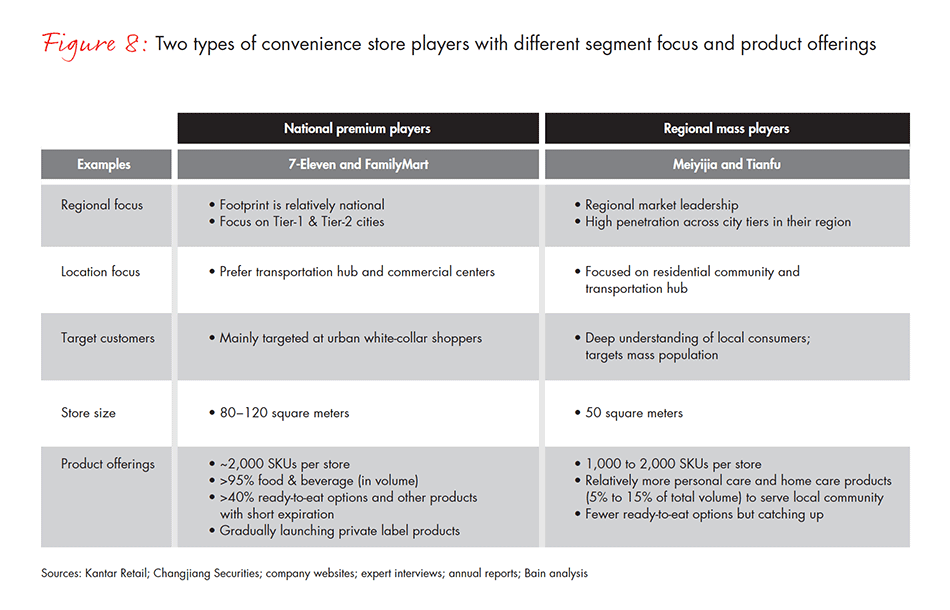
Of China’s top 10 convenience retailers, only FamilyMart and 7-Eleven have a national footprint across Tier-1 cities, with the others still maintaining a regional focus (see Figure 9). Among the leading banners, Meiyijia and FamilyMart are experiencing the fastest growth: 15% to 20% annually. Both are opening new stores and gaining shares steadily at the expense of competitors such as Quik and Haode, which closed some stores in 2015 due to heavy competition in Tier-1 cities and increasing cost pressure (see Figure 10).
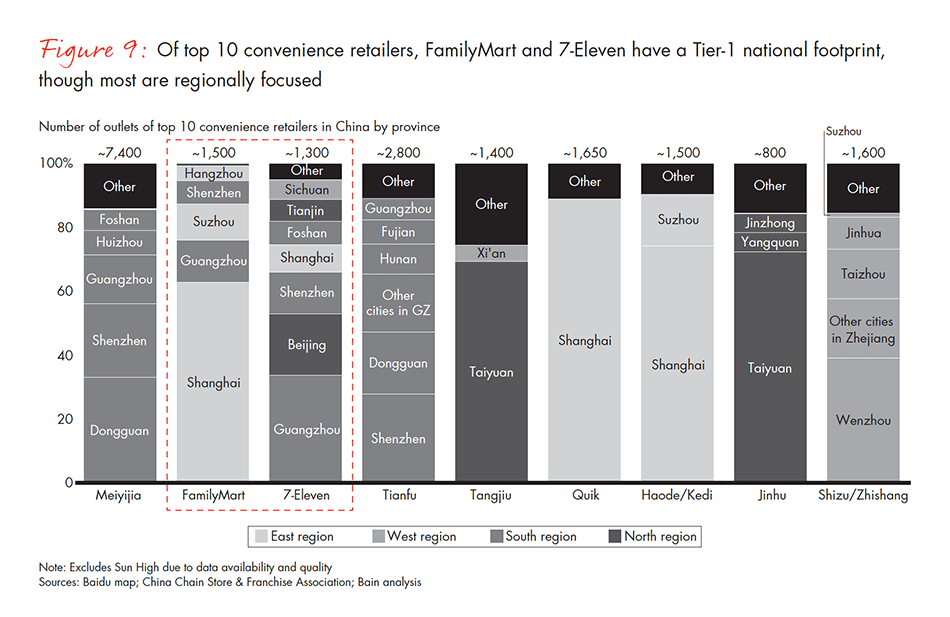
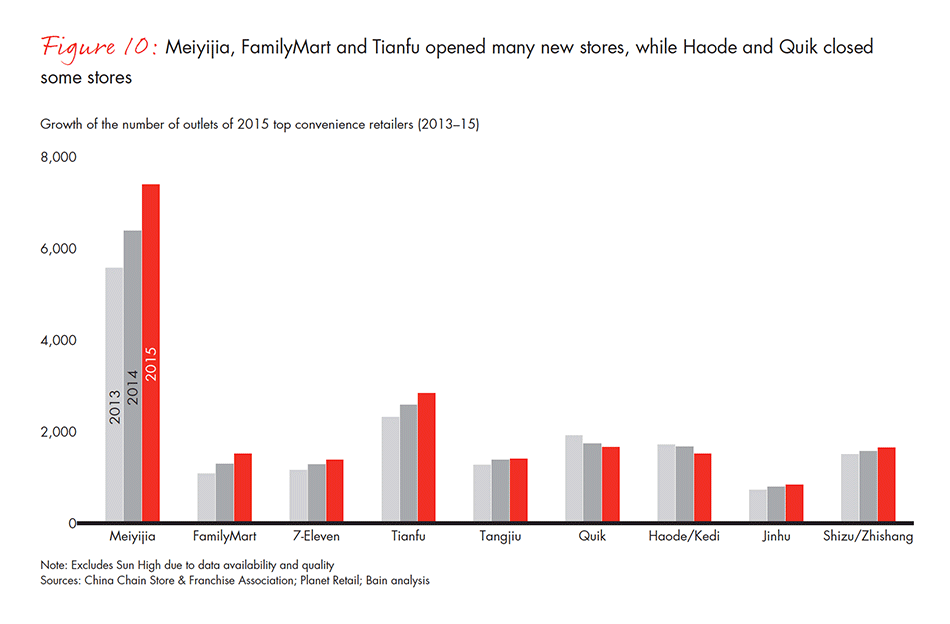
E-commerce’s unstoppable momentum
The expansion and evolution of China’s convenience store format has been impressive, but it pales in comparison to the country’s e-commerce channel, which continues to astonish. Digital FMCG sales grew by 36.5% in 2015. Along with this super-fast growth, the online marketplace is undergoing a rapid and continuing consolidation. The top 10 e-retailers accounted for 64% of total FMCG spending online in 2015, compared with 55% in 2014. The top 4 accounted for 57% of sales in 2015. Indeed, China’s e-commerce world remains dominated by Taobao, Tmall and JD, whose acquisition of Yihaodian will enable JD to compete head-on with Tmall as the leading online supermarket. Meanwhile, some smaller companies are experiencing quick and dramatic success. Among the big winners are online cosmetics platform Jumei, which grew nearly sixfold annually from 2013 to 2015, and competitor Lefeng, which grew by 245% during the same period (see Figure 11).
Online FMCG sales performance gets especially interesting when you look at the source of the value gains. Our research shows that digital sales are slowly chipping away at offline sales. In 2013, 60% of e-commerce growth was organic, representing sales that would not have been made offline, and only 40% came from consumers who were substituting for purchases that they otherwise would have made in physical stores. However, by 2015, organic growth represented 53% of the value growth, while substitution of offline purchases increased to account for 47% (see Figure 12).
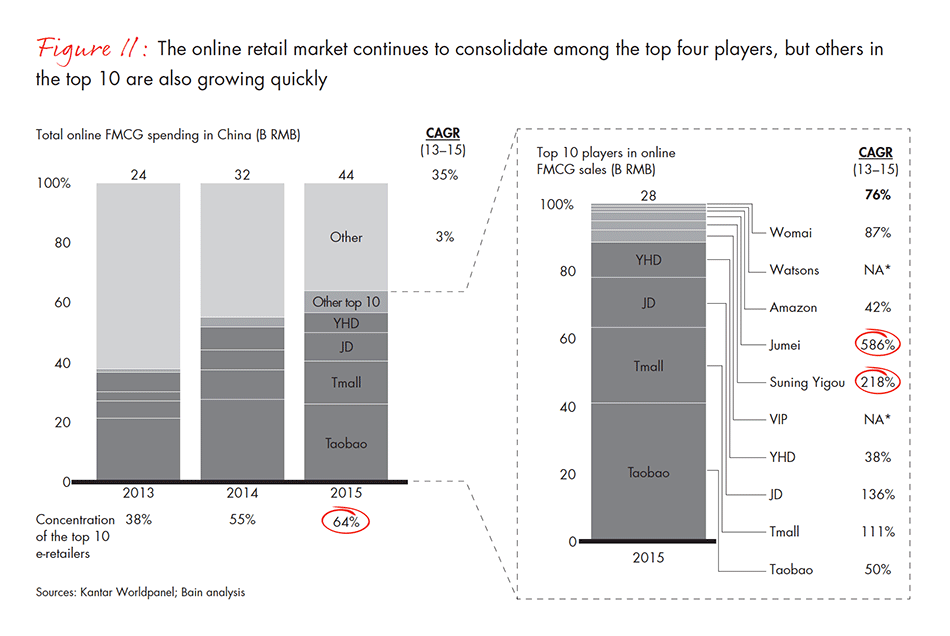
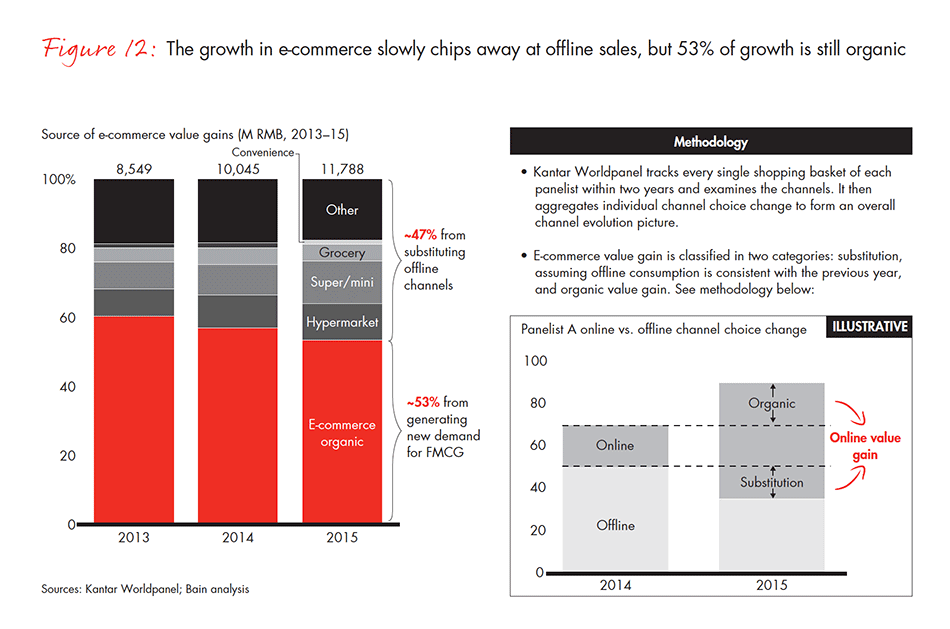
The boost in total online FMCG spending is primarily the result of massive volume growth; it rose by 69% in 2015. We learned that digital shoppers are buying more products, making more visits to online sites and purchasing across a broader number of categories (see Figure 13). This boost in volume has more than offset the decline in average selling prices, which dropped by 7% in 2014 and 19% in 2015.
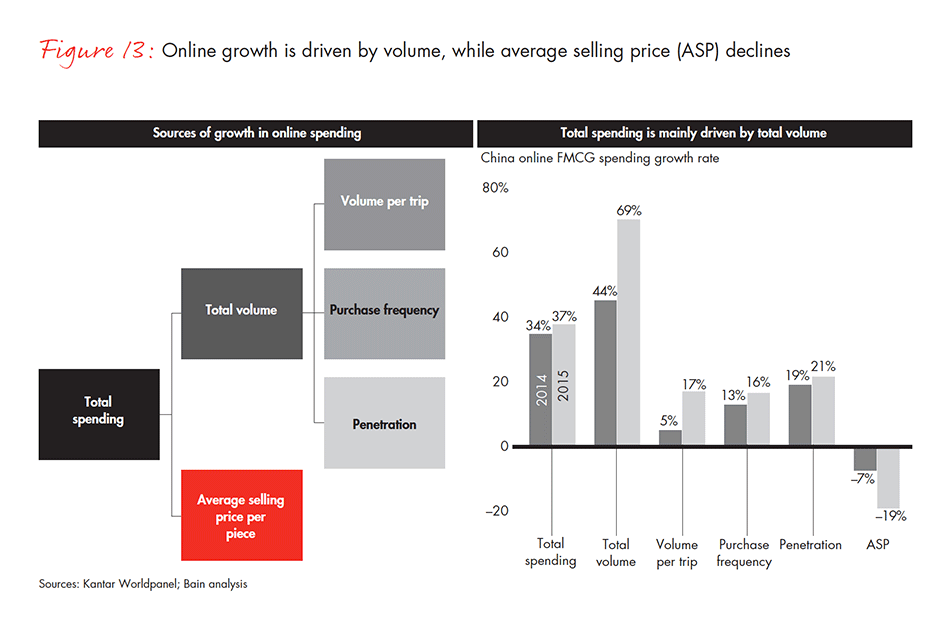
Why are prices dropping so steadily? It is the natural consequence of the diversification of online categories. As we explain in the 2015 China Shopper Report, Vol. 2, How Retailers Adapt to China’s “New Normal,” the first categories to achieve significant online penetration—infant formula, diapers, skin care and makeup—have the highest average selling price in both RMB per kilogram and RMB per pack. Now, as consumers continue to buy more categories like yogurt, biscuits, milk and shampoo, which are sold at much lower average prices, the average price online declines. The categories that include yogurt and fabric softener achieved record growth at an aggregated annual rate of 57% from 2013 to 2015, compared with the slower growth of more expensive goods such as the top three categories of diapers, infant formula and skin care, which grew by 15% annually (see Figure 14).
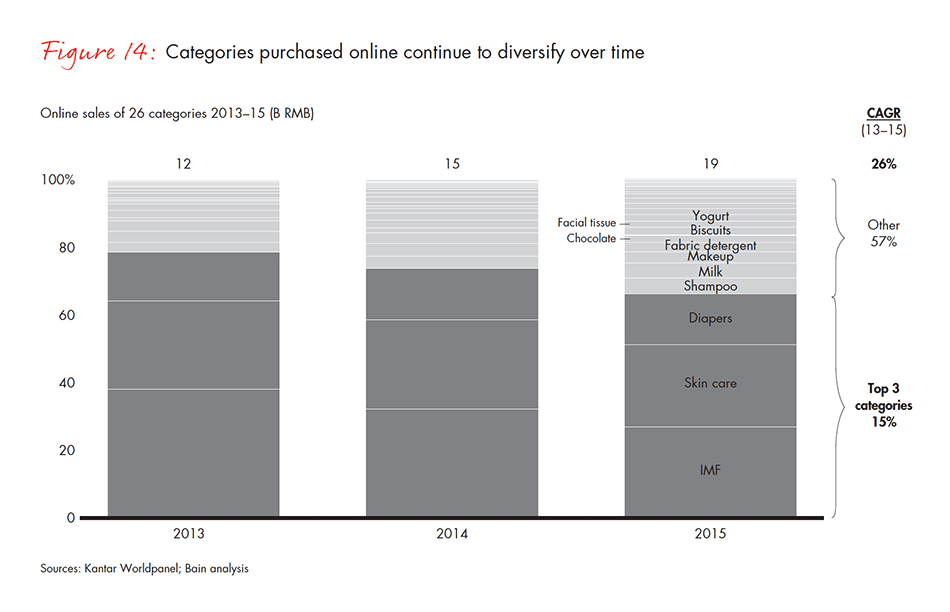
As China’s shoppers expand the range of categories they buy online, they are also continuing to turn to digital platforms for imported goods. In fact, imported FMCG items are four times more likely to be purchased online than in physical stores (see Figure 15). Nearly two-thirds of these online sales are imported products or products purchased on promotion; this is more than double the percentage of imported and promotion items bought in physical stores. Indeed, promotions are steadily growing in importance for China’s retailers. Our research found that in 2015, fully 40% of online FMCG purchases were made on promotion—this contrasts with 19% for purchases made in physical stores (see Figure 16).
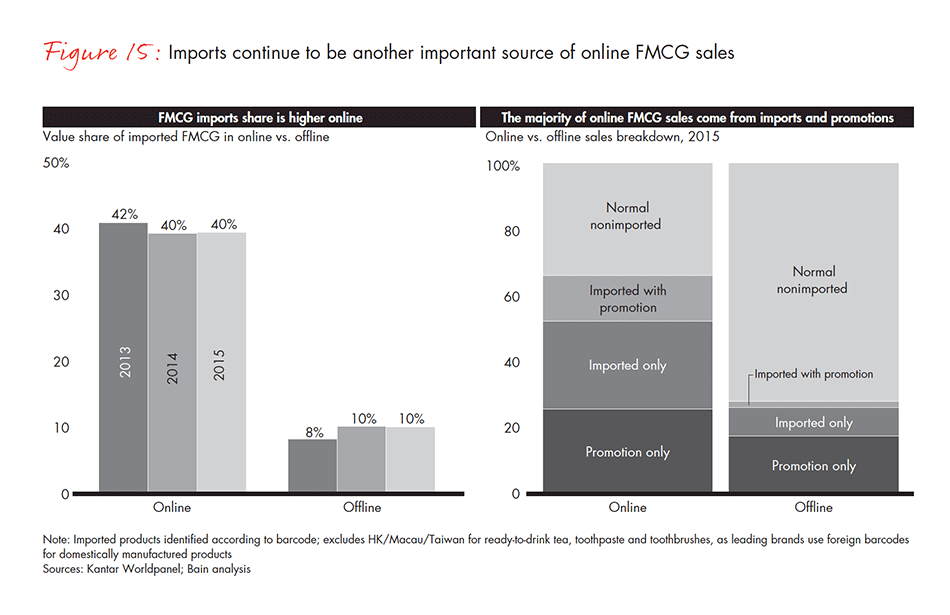
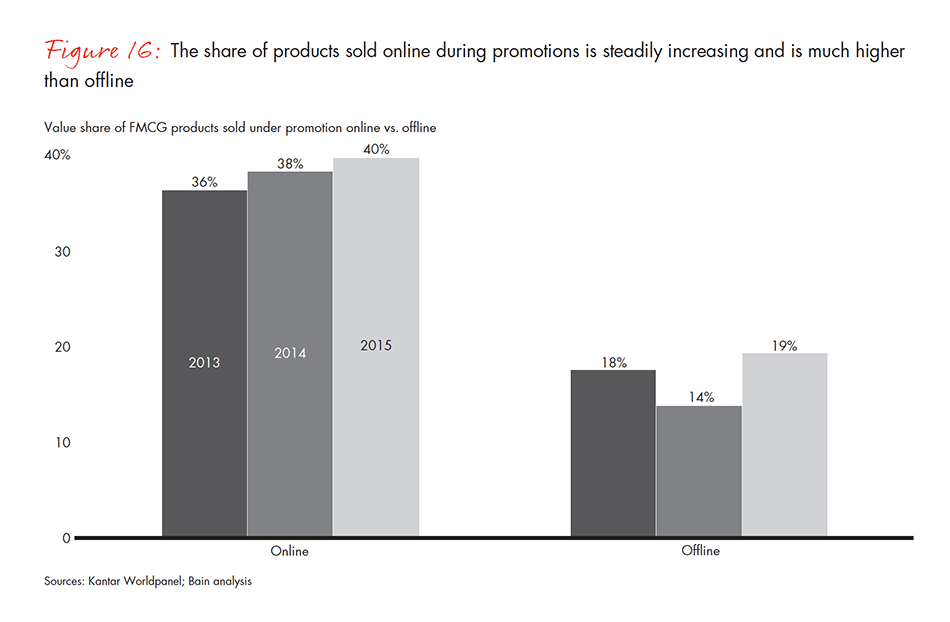
The double-eleven jolt
Every November, the retailing world turns its eyes toward China and the most popular retailing promotion ever conceived: 11/11 Singles’ Day. It is, by far, the biggest online sales event anywhere. Alibaba’s site alone generated $17.8 billion in sales on the one-day shopping festival in 2016, a 24% increase over 2015. An incredible 82% of those sales were made from mobile devices. Users from 235 countries participated in this shopping festival and international transactions rose by 60% compared with 2015. And other platforms did well too: JD experienced a 78% increase in sales from 2015, and Suning enjoyed a stunning 193% rise in sales. As part of our research, we conducted a deep dive into sales performance on 11/11, identifying significant trends. For example, in 2015 online promotions held for 11/11 helped categories with relatively low online penetration, such as toothbrushes and shampoo, attract more shoppers (see Figure 17). Toothbrush sales jumped by 163%, and shampoo sales rose by 103% during 11/11 promotions. Meanwhile, higher-penetrated online categories registered less robust growth. Infant formula sales grew by only 19%, for example.
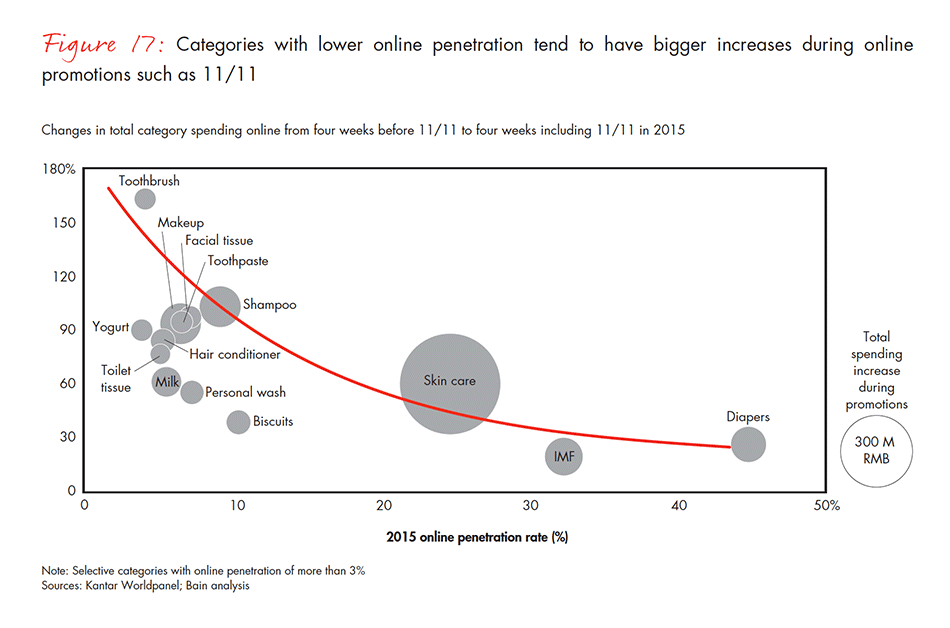
Three segments of shoppers contributed to the total spending increase, and each is significant:
- existing online shoppers of a particular category who used the occasion to purchase more, particularly in categories such as laundry detergent, facial tissue and infant formula;
- shoppers who waited to make their purchases during the 11/11 period; and
- new shoppers who were attracted to an online category because of the promotion, using the occasion to buy categories such as fabric softener, shampoo and biscuits.
To perform this analysis, we compared total online category spending in the 4 weeks prior to 11/11, the 48 weeks prior to 11/11 and four weeks including 11/11. Existing shoppers who purchased more contributed to 28% of the value gain. The biggest contribution—76% of the total value increase—was made by shoppers who were considered new to the online category (see Figure 18).
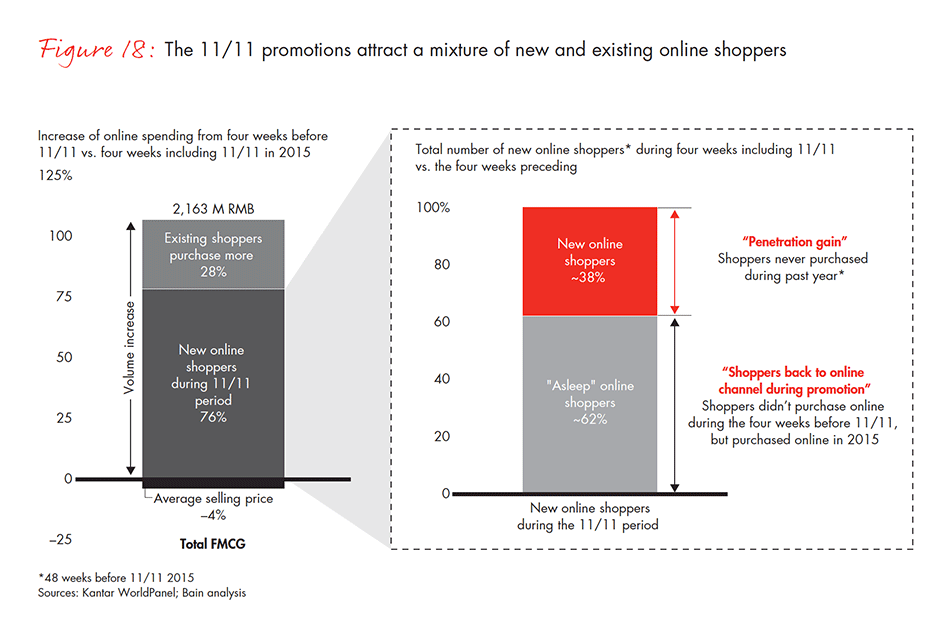
These “new” shoppers were segmented two ways. Approximately 38% had not shopped the online category in the past 12 months and contributed true gains in penetration. By comparison, around 62% had purchased in the category during 2015, but not in the four weeks prior to 11/11. They were waiting for the sales event, or buying categories that didn’t require frequent purchases. One distinct effect of the 11/11 promotion is that it temporarily shifts sales to online platforms from offline channels (see Figure 19). But the impact is most dramatic in highly penetrated categories such as diapers, where online volume share reached around 55% during the 2015 Singles’ Day promotion before dropping back to 45%.
There are clear lessons in our analysis. For example, as we mentioned, in categories such as biscuits, fabric softener and shampoo, the majority of the spending increase consists of shoppers trying the category for the first time. In such categories, online promotions serve as an important recruitment tool.
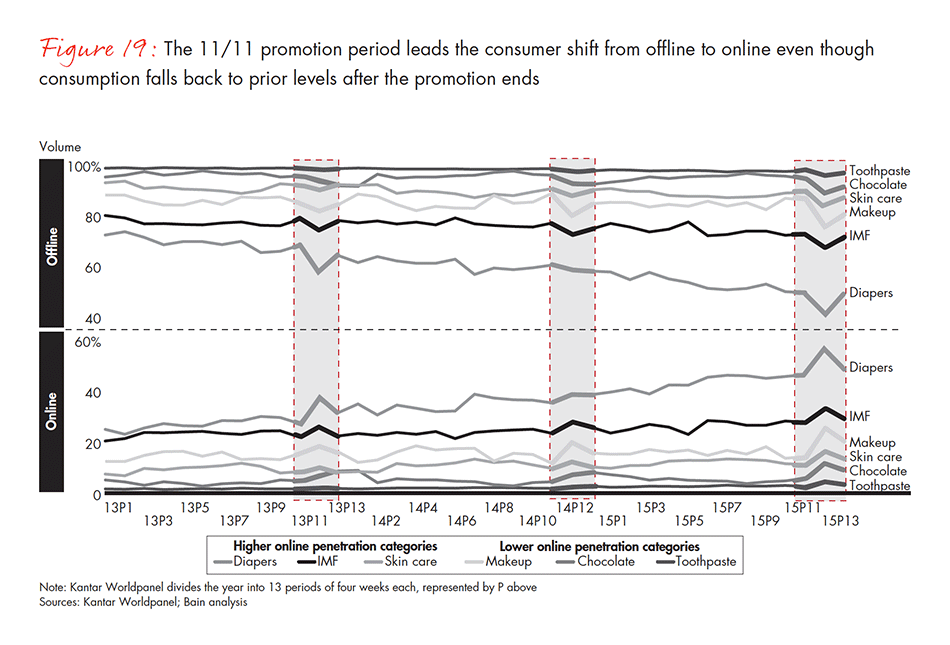
Another significant finding from our deep dive into 11/11 activity is that 11/11 is not just about promotion and bargains; it also sees a rise in average selling prices in categories such as sanitary protection and toothbrushes (see Figure 20). Premiumization in any category during a promotion would seem counterintuitive, but we believe there is a simple explanation: A higher proportion of imported products are being promoted and sold during 11/11. For example, both sanitary protection and toothbrushes saw double-digit gains in the share of imported products sold during the sales event. Meanwhile, category leaders in toilet tissue and facial tissue, such as Vinda, took advantage of 11/11 to market their premium products, further contributing to the premiumization trend during Singles’ Day promotions.
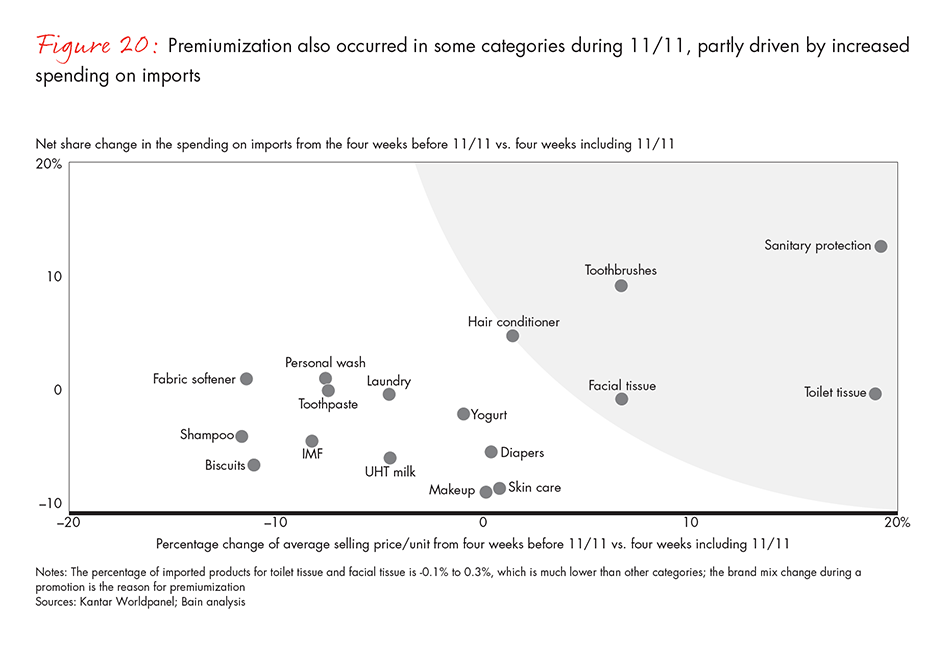
Indeed, China’s Singles’ Day online sales festival continues to fascinate, attracting the attention of FMCG companies and e-retailers around the world. There’s nothing like it for propelling online sales or for learning how to make the most of the dynamic digital marketplace.
Implications for retailers
Last year, we reported that to win in China, large-format grocery retailers need to do several things in parallel:
- adhere to a local or regional focus;
- prune the store portfolio and close underperforming stores;
- adapt store formats and introduce smaller formats, similar to convenience stores; and
- implement O2O strategies, using stores for “pick and pack” and last-mile delivery.
Today, these priorities are even more true and urgent. The performance of large-format retailers has deteriorated even further, and growth is mostly the result of new openings, not increased same-store sales, which have continued to decline. The increase in online penetration over the coming years will exacerbate this downward trend for large-format retailers. Retailers will need to reduce store capacity as more consumers move to online retailers for their FMCG (and other) purchases.
In addition, lessons from international retailers in other markets tell us that the online grocery business is not a profitable one. Among other reasons, this is because consumers do not pay the full cost for pick and pack and delivery services. For large-format retailers, these factors increase the importance of reducing costs and streamlining operations. An obvious first step is to increase pressure on suppliers to extract better margins. Suppliers maintain a strong bargaining position against retailers in China. However, retailers need to take a systematic look at store operations. They should examine all cost categories carefully. Some retailers in China have started on this path.
As for O2O, Alibaba Group Executive Chairman, Jack Ma, provided a valuable prediction in a recent letter to shareholders. “Our traditional e-commerce business is already undergoing rapid change and progress,” he wrote. “In the coming years, we anticipate the birth of a re-imagined retail industry driven by the integration of online, offline, logistics and data across a single value chain. With e-commerce itself rapidly becoming a ‘traditional business,’ pure e-commerce players will soon face tremendous challenges.”
Indeed, the future opens a vast world of possibilities for retailers and platforms to work together more effectively to deliver this new and exciting retail industry to Chinese consumers.
About the authors and acknowledgments
Bruno Lannes is a partner with Bain’s Shanghai office. Wei Yu is a partner with Bain’s Shanghai office. Jason Ding is a partner with Bain’s Beijing office. Marcy Kou is CEO at Kantar Worldpanel Asia. Jason Yu is general manager at Kantar Worldpanel China.
Acknowledgments
This report is a joint effort between Bain & Company and Kantar Worldpanel. The authors extend gratitude to all who contributed to this report, in particular Weiwei Xing, Sherry Jiang and Yue Chen from Bain & Company and Rachel Lee, Tina Qin and Cathrine Chang from Kantar Worldpanel.



















